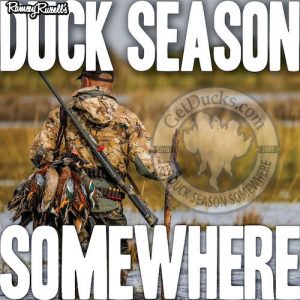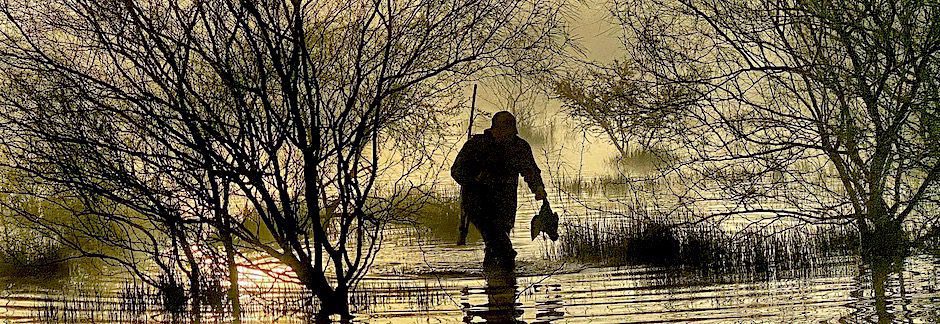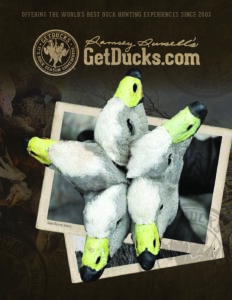MOJO’S Duck Season Somewhere Podcast
EP 481. Speaking Truth To Power: Bio-political Mississippi Wildlife Management

Ricky Mathews is a fearless force of nature when it comes to doing right by Mississippi’s treasured wildlife resources and the people, like himself, that enjoy hunting and fishing. Using what he calls “reporting muscle” to “speak truth to the power,” his hugely popular SuperTalk Outdoors radio program oftentimes crashes meteorically through controversial topics, like the ones he describes candidly today. For most of us, hunting and fishing is part of our cultural identity. It’s who we are. We need to ask ourselves–we must insist in knowing–how much of our wildlife management policy is science-based versus politically motivated? And how might those political influences be purposefully self serving? Implications can be long lasting, far reaching, and detrimental to the greater good–whether in Mississippi or your own home state.
EP 480. Boone and Crockett Club: Fair Chase Ethos Then and Now

Smart as he may have been, nearly everything ol’ Grandad taught about fair chase hunting ethics originated in the late-1800s when yesteryear hunters formed the venerable Boone and Crockett Club. Their forever vision didn’t stop there. Backbone of the North America Model of Wildlife Conservation, Boone and Crockett helped set aside millions of acres in perpetuity, brought hunters-as-conservationists into mainstream American conciousness, worked to establish the world’s most enviable collection of wildlife-minded legislation, and formed other wildlife conservation organizations to include Ducks Unlimited. Tony Schoonen and Luke Coccoli colorfully describe 137 years of roll-up-your-sleeves-and-get-‘er-done milestones that transformed America into an amazing place to hunt wild animals. Beyond coonskin caps and record books, our ancestors realized we were “borrowing from future generations,” and did something about it. Do we have what it takes to continue what they started? Listen and let us know your thoughts.
Related Links:
Boone and Crockett Club https://www.boone-crockett.org
EP 479. Lake Pickle

“I grew up on Andy Griffith and Primo’s Truth About Hunting,” says Lake Pickle while humbly describing his specifically singular dream job–to be a Primo’s cameraman. When opportunity knocked, he opened the door, never looked back. He talks about important influences, encouraging conversations, paying dues, learning the ropes, finding his way in the outdoor industry, experiencing parts of the US much different than his own back yard–to include his thrilling first elk hunt–giving back to the resource, swinging for the fences, and why he can’t imagine ever leaving Mississippi. Good stuff.
EP 478. Favored Gauges, Shot Sizes and Chokes for Waterfowl: BOSS Shotshells Updates

Fellow Mississippian, Aaron Carter of Boss Shot shells, and I take it to the plug discussing Arkansas speckled bellied goose hunting, our favorite waterfowl loads and how “compensation science” still influences waterfowl shot shell preferences decades after non-toxic ammo was mandated for waterfowl hunting. Running through our own favored tried-and-true gauges, shot sizes and chokes for ducks and geese, we then cycle fluidly through need-to-know BOSS Shot shells happenings to include why buffered Warchief payloads deliver superior patterns downrange, why new steel shot rounds are hitting the market, and how cutting-edge biodegradable wads are better for producing tighter patterns and a cleaner hunting environment. Whether a long-time Boss Shot shell customer or shopping alternatives to high-recoil compensation science, this epsiode’ll have your trigger finger itching.
EP 477. Duck Season by the Numbers: Estimating North America Duck Populations and Harvests

Whether good years or bad, North American duck hunters probably harvest more ducks annually than the remainder of the world combined. There, I said it. Prove me wrong. This amazing feat is accomplished using science-based management that emphasizes maximum sustained yield and is the world’s envy. A duck hunter since childhood, Brad Bortner is former USFWS Chief of Migratory Birds. While his job description encompassed far more than just waterfowl, he guides us through the murky, too oftentimes misunderstood swamp of managing North America duck populations and harvests, shining a q-beam on need-to-know, by-the-numbers topics. What goes into setting duck seasons and bag limits? What’s adaptive harvest management (AHM) and how does it compare to models used elsewhere worldwide? How accurate are these estimates? Why aren’t waterfowl surveys like counting piggy bank coins? What about the 2-year time lag between population surveys, harvest estimates and season settings–why does this time lag exist, should we be concerned? What is HIP (Harvest Information Program), what’s its relevance, how’s it used, and how can each citizen-scientist duck hunter improve harvest estimate accuracy–and why should we care? Listen. The duck hunting world is buzzing around these topics right now. Be well informed.
**********
“You get what you put in, and people get what they deserve.” – Kid Rock
**********
EP 476. California Leads Nation’s Duck Harvest Thanks to CWA

While America’s most populated state is often times characterized by its big blue-city progressive politics, California consistently harvests more ducks than any other state. It’s not by accident. Far from it. Founded in 1945, California Waterfowl Association has exerted David-versus-Goliath efforts to improve habitat and wetlands, increase waterfowl production, hunter access and recruitment despite the Golden State’s notorious political climate. John Carlson, Mark Hennely, Jake Messerli and I wade through a boundless marsh of hard-earned accomplishments—producing 1-million wood ducks, salvaging eggs, banding ducks, ensuring Klamath Basin’s permanent water rights, providing Veteran Hunt Program, conserving wetlands to reduce a carbon footprint, establishing CWA Hunt Program, embracing new field-to-fork mindsets, replacing kids screen time with nature, tackling ongoing challenges. Could this grassroots conservation model improve duck hunting in your home state? How might death-by-a-thousand-cuts, modern-day duck hunting improve if embraced nationwide? Listen and let us know your thoughts.
Related Links:
California Waterfowl Association https://calwaterfowl.org
Save It For The Blind Podcast https://calwaterfowl.org/save-it-for-the-blind-podcast
EP 475. Talking Ducks with Devney

Sifting through random solving-duck-world topics like we duck hunters do is a lot like poking glowing embers around late-night campfires. Hardly anyone better to do that with, either, than Delta Waterfowl’s John Devney. He packs facts, common-sense and, optimism to the party, sharing them like cold pearly pops and brats (or smores for the youngsters). Prairie conditions, nesting ground updates, voluntary restraint, dryfield hunting then versus nowadays, duck harvests in Canada compared to the United States, and duck hunter numbers–changes since 1999 are mind-blowing–and more are discussed in-depth. Small chance these topics won’t make their way into your next world problem-solving campfire talks.
EP 474. Ducking Roadtrips and Red Ruddy Ducks

Heath Hoogerhyde hails from Michigan, but his quests for waterfowl hunting experiences take him far beyond his home state’s mitten-shaped borders. Through mostly self hunts, personal contacts and swap hunts, he’s amassed an enviably impressive collection of waterfowl species and experiences at a relatively young age. He describes how he got into duck hunting, how and why he began chasing waterfowl species experiences, quality versus quantity, favorite species and once-in-a-lifetime type trophies for most of us that now adorn his hunting room, the advantages and disadvantages of do-it-yourself hunting around the US. Almost entitled this episode “better luck
Related Links:
North American Waterfowl List https://www.getducks.com/north-american-waterfowl-species/
World Waterfowl List https://www.getducks.com/waterfowl-of-the-world/
EP 473. Bayou Beast Living

After enjoying plates of steaming-hot boudin and digging through fresh batches of made-from-hand cane duck and Oiu Caille (spotted goose) calls, long-time friend Dale Bordelon and I move to his front shop to catch up. He walks the walk of bygone South Louisiana times, his entire approach to duck hunting–and life–is that of his ancestors. We talk about food, new calls, and a growing collection of old pump-action killing sticks, him sharing sure-fire strategies for tricking wary, late-season gray ducks and leaving the swamp happy regardless. We also talk about the very last made-by-hand cypress dugout ever made in Louisiana and why it symbolizes a passing of the torch.
EP 472. Are We Killing Too Many Ducks? Better Understanding Duck Population Management

Regarded by many as the absolute go-to guy when it comes to empirically describing North America’s duck populations, Dr. Todd Arnold is at University of Minnesota, where his research emphasis includes developing waterfowl population models to guide management activities and predict future populations. “Are we killing too many ducks?” I asked repeatedly throughout our conversation. His thoughtful, plainly worded answers provide greater understanding of Adaptive Harvest Management—its inputs, assumptions, strengths, weaknesses—leading us to in-depth discussions about our beloved mallards and pintails, and whether science-based, hunting-related harvest affects sustainable duck populations.








